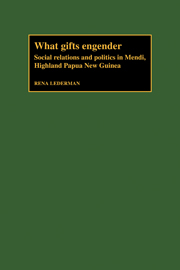Book contents
- Frontmatter
- Contents
- List of tables, figures, and maps
- Preface
- Acknowledgments
- 1 Mendi coming into view
- 2 Sem relations: solidarity and its limits
- 3 Twem: personal exchange partnerships
- 4 Gender ideology and the politics of exchange
- 5 Twem and sem in context
- 6 Sai le at Senkere: the politics of a Pig Festival
- 7 “Development” in Mendi
- Appendix A The research community
- Appendix B The “accounts sample” and some comments on research methodology
- Notes
- Glossary
- References
- Index
Appendix A - The research community
Published online by Cambridge University Press: 04 August 2010
- Frontmatter
- Contents
- List of tables, figures, and maps
- Preface
- Acknowledgments
- 1 Mendi coming into view
- 2 Sem relations: solidarity and its limits
- 3 Twem: personal exchange partnerships
- 4 Gender ideology and the politics of exchange
- 5 Twem and sem in context
- 6 Sai le at Senkere: the politics of a Pig Festival
- 7 “Development” in Mendi
- Appendix A The research community
- Appendix B The “accounts sample” and some comments on research methodology
- Notes
- Glossary
- References
- Index
Summary
The research on which this book is based was conducted primarily in the community that hosted my husband and myself during our stay in Mendi. In the government records and on maps, this community is known officially as the census unit “Waparaga,” although residents and other Mendi call it Wepra. (In this appendix, census unit names are indicated with quotation marks; local names are left unmarked.) It is located in the Upper Mendi census division of the Mendi Valley. In the most recent census available to me, which was conducted in late 1979, “Waparaga” was reported to have a population of 330 persons, 68 of whom were absent from the village at the time the census was conducted. The details are summarized in Table A.I. In contrast, the 1975 population census reported that “Waparaga” had a total population of 313, of whom 31 were absent at the time of census.
”Waparaga” is one of three census units in Suolol tribal territory. The other two are “Kombal” and “Kuma.” (In the text, I refer to “Kornbal” and “Waparaga” – both in the southern part of Suolol tribal territory, and comprising the neighborhoods known locally as Ponea, Wepra, Kombal, Senkere, and Molmanda – as the Senkere community, after the name of the main ceremonial ground in the area.) In 1979, the population figures for “Kombal” were 121 male and 126 female residents plus 34 absentees, for a total population of 281. At “Kuma” in the same year there were 335 male and 338 female residents plus 72 absentees, totaling 745 people. Four years before, “Kombal” had a population of 276 and “Kuma” 720.
- Type
- Chapter
- Information
- What Gifts EngenderSocial Relations and Politics in Mendi, Highland Papua New Guinea, pp. 238 - 242Publisher: Cambridge University PressPrint publication year: 1986



